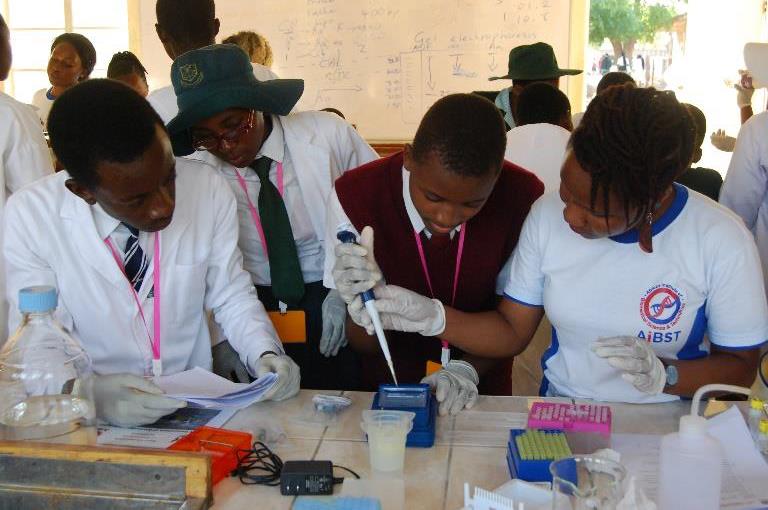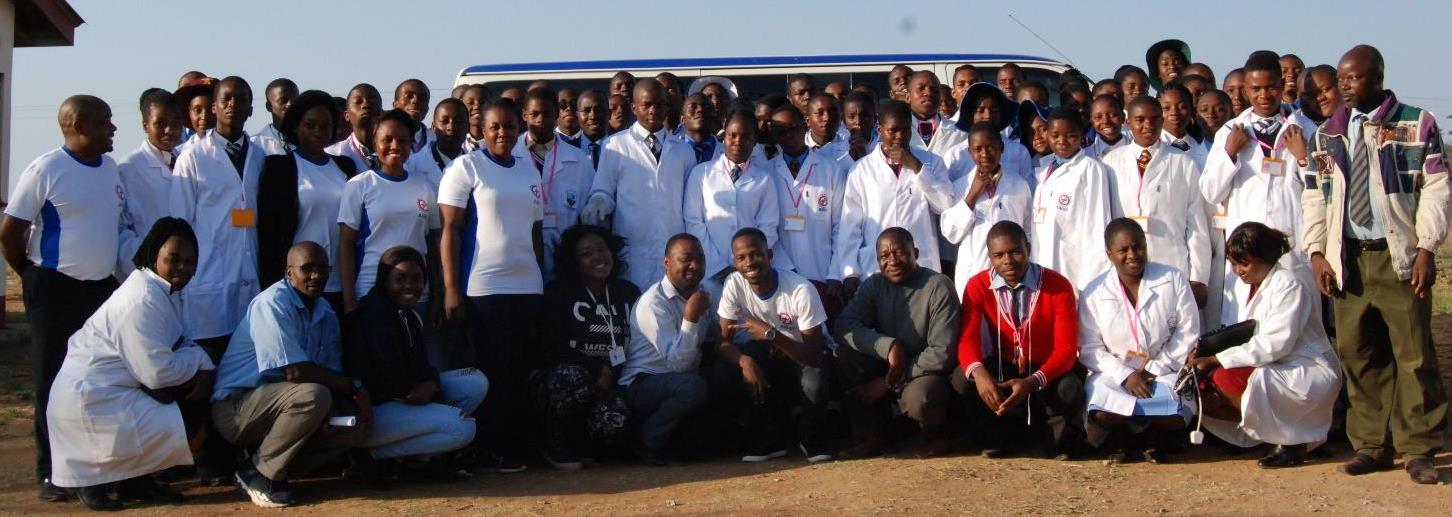 The NGBS was a nationwide programme in Zimbabwe engaging secondary school students with genomics technologies and careers in genomics technology. The project, run by the African Institute of Biomedical Science and Technology (AiBST), sought to inspire high school students to identify local health challenges, and through community engagement, originate research-based solutions.
The NGBS was a nationwide programme in Zimbabwe engaging secondary school students with genomics technologies and careers in genomics technology. The project, run by the African Institute of Biomedical Science and Technology (AiBST), sought to inspire high school students to identify local health challenges, and through community engagement, originate research-based solutions.
NGBS supports students to form science teams, provides training on how to conduct biomedical research and encourages them to identify a community health challenge and engage community stakeholders in conducting research around it. Stakeholders include the wider community, scientists, local health practitioners and traditional leaders.
The NGBS training was conducted in five out of Zimbabwe’s ten provinces; Manicaland, Bulawayo, Masvingo, Matebeleland South and Midlands. 375 learners from both rural and urban schools were trained in theoretic principles of forensic science, genomic medicine and genomics technologies. The students also attended lectures on biomedical entrepreneurship, scientific method development and research proposal development, as well as an overview of careers in the biomedical sciences field. In addition, they took part in practical training in laboratory techniques (standard operating procedures, sample preparation, etc) and genomics techniques (DNA amplification, restriction fragment length polymorphism (RLFP), gel electrophoresis, etc).
The solutions generated by the students as part of the programme were show-cased at a final exhibition where community leaders, local business and relevant authorities were all present. The idea was to challenge the community to consider the solutions for implementation.
OBJECTIVES
- Raise students’ awareness of research culture and basic research skills
- Generate interest in research- and technology-driven degrees such as biomedical science, as viable career options for students
- Encourage learners to conduct real-life research in their communities
- Students engage and inspire their communities to participate in co-creating solutions for local health problems
- Scientists gain ideas of refining research methodologies particularly involving the public
- Policy makers are inspired to push for financial and policy support towards early establishment of a research culture in students
METHODOLOGY
Baseline survey questionnaires were administered to a sample of 80 STEM (Science, Technology, Engineering and Mathematics) schools from 5 provinces to establish STEM enrolment, distribution according to gender, subjects, science infrastructure and historical involvement of the school in science related projects.
38 schools were selected from the 80 and trained on science careers and research skills. End of training surveys were also administered to assess the impact of the training.
School research proposals were assessed by a team of 6 scientists using a score board system. The trained learners were automatically entered into the NGBS competition, and tasked to form teams and come up with community-based research projects in the areas of genomics, forensics and/or molecular diagnostics.
The submitted projects explored the application of genomics technologies to solve community problems and were supposed to involve community leadership structures, scientist-mentors from local universities and local health experts. In so doing, the learners practiced engaging policy makers in pushing research driven agendas for development and to engage their communities in co-creating solutions for local health problems.
During research projects, students administered standard questionnaires and conducted focussed group discussions with community stakeholders, responses of which were used to assess interest generated by the community and the extent to which they participate in core creating solutions.
The Ministry of Higher and Tertiary Education, did an independent assessment of the impact of the projects on promoting and influencing the Ministry’s policies on STEM. The exhibition adjudicators’ developed an assessment tool to measure the impact of the project in developing students’ research and public engagement skills
SUCCESSES
- The fact that the NGBS programme has reached as far as rural schools is an important milestone, given that rural schools have been known to be marginalised and lagging behind with respect to science, technology and innovation programmes. However, this does not in any way reflect inability with respect to science, technology and innovation. It was discovered that learners in rural schools are very intelligible in science subjects, but just lack opportunity to express their capabilities which is a barrier to realising their potential. At a national scale, this is a disadvantage as a lot of innovative ideas can be missed. The NGBS programme sought to unearth such hidden talents by providing an equal opportunity to both rural and urban learners to be trained and enhance capacity in genomics technologies.
- Students expressed their excitement of being taught by practising scientists and the opportunity to handle sophisticated research equipment that was not present in their schools. The concepts and experiments on forensic investigations were most exciting to them. This helped the training team to emphasise forensic science as a gateway to inspire students towards scientific research.
- Teachers confessed that they too were learning as the students were learning because they had not had access to equipment during their own time. The tutors remodelled the training to incorporate teachers’ needs though it was not very easy since some teachers felt a bit embarrassed to learn together with their students. After the training cycles, the team decided to plan a special program to train teachers on research protocols.
- Community members who took part in the research as the advisory team observed that the approach added value to the community since people appreciated the power of science in solving local problems without having to wait for special intervention.
- The final exhibition by students was done in the presence of five key institutions responsible for shaping health and education policies; Ministry of Higher and Tertiary Education, Ministry of Primary and Secondary Education, Ministry of Justice, legal and parliamentary affairs, Medical Research Council of Zimbabwe, and National Biotechnology Association of Zimbabwe, and the African Institute of Biomedical Science and Technology. The Ministry of Higher and Tertiary Education, immediately adopted three of the exhibited projects for further development through government’s innovation hubs.
KEY LEARNING
- Involving a whole spectrum of community stakeholders makes research more relevant to the community. The NGBS project involved the traditional community leaders (Chiefs), Church leaders, political leaders, local health experts and scientist mentors.
- The collaboration brought a sense of ownership by the stakeholders which helped reduce costs as stakeholder’s volunteered services and infrastructure.
- The project involved the Ministry to whom results of the project were relevant. They were helpful in facilitating access to policy makers. They adopted three of the research projects for further development and went on to present the project to other government departments and on international platforms.
- It is crucial to plan for capacity building of the teachers who would work with students when they get back to school. It is an oversight to assume that teachers know how to perform the relevant experiments especially in situations where schools are from remote areas. Absence of laboratory equipment at schools results in teachers only doing theory and in the process be out of touch with practical experiments. It was also disturbing to hear some teachers confessing that during their university time, they too did not do significant experiments to be confident enough.
This work is licensed under a Creative Commons Attribution 4.0 International License





Please Sign in (or Register) to view further.